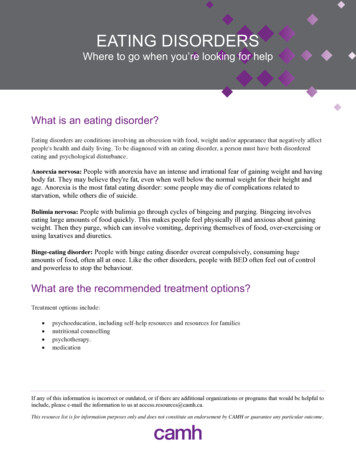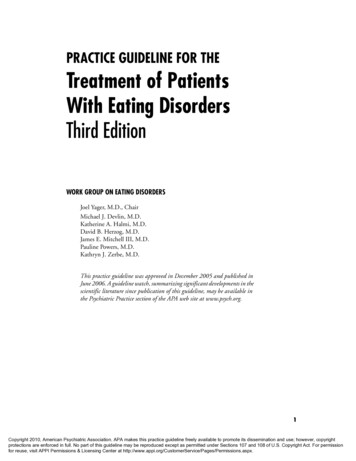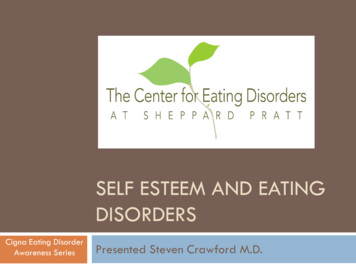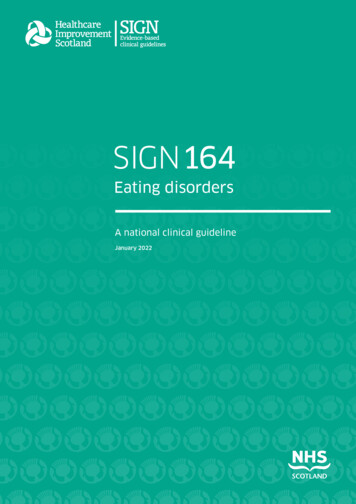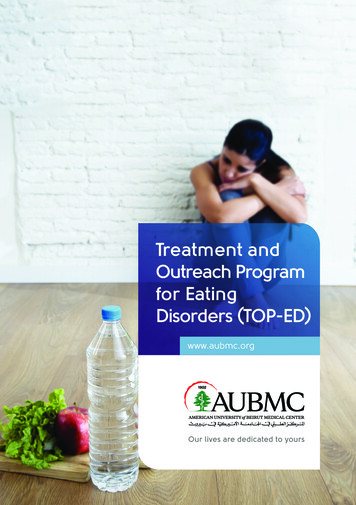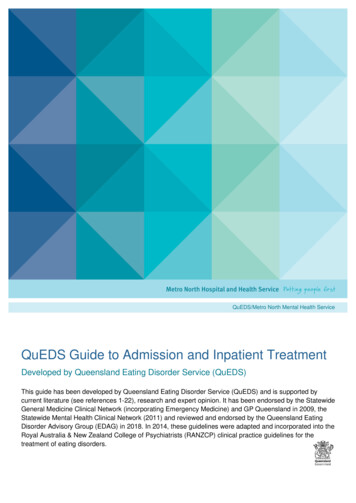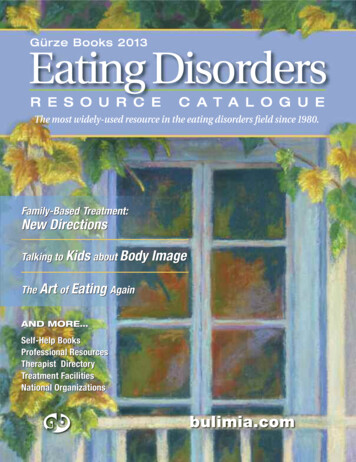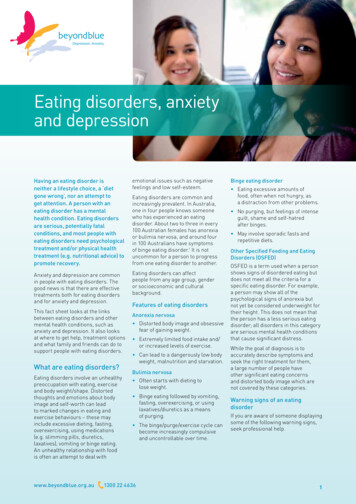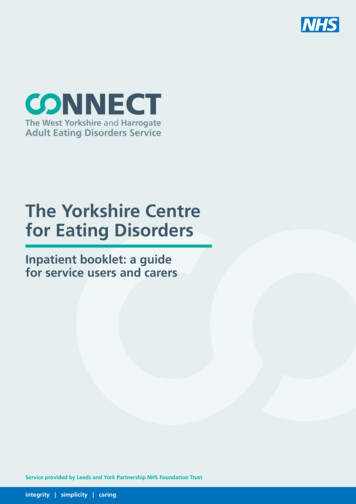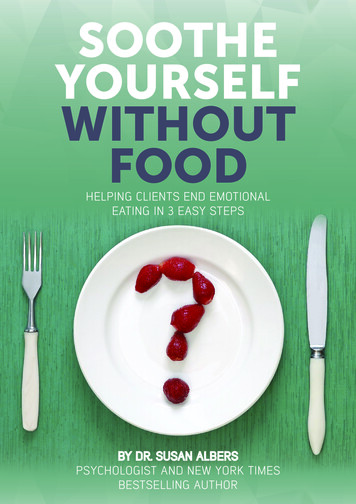
Transcription
We acknowledge the traditionalcustodians of the land on which we meettoday and pay respect to Elders past,present and emerging.We also extend that respect to otherAboriginal and/or Torres Strait Islanderswho are joining us here today.David R Horton, creator, Aboriginal Studies Press, AIATSIS andAuslig/Sinclair, Knight, Merz, 1996.View an interactive version of the AIATSIS mapwww.abc.net.au/indigenous/map/Header Artwork produced for Queensland Health by Gilimbaa
Treating Eating DisordersMade EasyA Simple 3-Step GuideWarren WardDirector, QuEDSMetro North Mental Health
High mortality rates 10-20% for Anorexia Nervosa The highest mortality rate of any psychiatric illness
Anorexia Nervosa: Mortality RatesMortalityrate per1000 personyearsANSCZBPADDepression52.821.6 12 times higher in AN than patients without AN A fifth of deaths in AN due to suicide Higher mortality associated with low BMI at presentationRef: Arcelus et al, Mortality Rates in Patients With Anorexia Nervosa and Other Eating Disorders A Meta-analysis of 36Studies, Arch Gen Psychiatry. 2011;68(7):724-731
Eating Disorders are common, andincreasing in prevalence 1 in 20 Australians has an eating disorder* Approximately 15% of Australian women experience an eating disorderduring their lifetime* The number of people in Australia with ED behaviours doubled in 10years from 1995-2005 *www.nedc.com.au Hay PJ, Mond J, Buttner P, Darby A (2008) Eating Disorder Behaviors Are Increasing: Findings fromTwo Sequential Community Surveys in South Australia. PLoS ONE 3(2)
The cost of eating disorders First report intosocioeconomic impact ofEDs Deloitte Access Economics in 2012: 913, 986 Australians 69.7 billion 1,828 deaths 515 males 1313 females
Early intervention significantly reduces the duration and impact of illness, andincreases the rate of sustainable recovery
Eating Disorders are treatable Recovery is possible (approx 70% after 5 years) Evidence-based treatments are available To get better, the patient needs (a lot of) help from you,often for several years
What causes eating disorders? The causes of eating disorders are complex andinclude GeneticPersonalityEarly attachment problems (trauma/abuse/neglect)Obesity Bullying and teasing The culture and media/certain subcultures Stressors Dieting Starvation syndrome
Dieting & Eating Disorders are moreprevalent in Western cultures Idealisation of thinness Abhorrence of fat We are told that to behappy, successful anddesirable we need to bethin Many women thereforebase self-esteem on theirphysical appearance
The impact of TV on teenage girls Within 3 years of introduction of TV to area in Fiji: Eating Disorder symptoms increased 5-fold Vomiting to control weight increased from 3% to 15% 74% felt “too big or fat” 62% dieting in past month Favourite programs included Melrose Place, ER, Xena: WarriorPrincess.Becker et al (2002) British Journal of Psychiatry, 180, 509-514
The previous study (2002) wasdone before: FACEBOOK (2004) THE IPHONE (2008) INSTAGRAM (2010) FRONT-FACING CAMERAS AND SELFIES (2010) SNAPCHAT (2011)
Is body image concern an epidemic? 2015 Mission Australia National Survey of YoungAustralians 19,000 15-19 year olds 26.5% highly concerned about body image
Treatment made easy: 3 Steps1. Medical stabilisation2. Weight restoration3. Psychotherapy
Reasons for each step1. Medical stabilisation: to keep patient alive2. Weight restoration: to reverse cognitive effects of starvation(impaired capacity)3. Psychotherapy: to help patient resist future urges tolose weight
Keeping patients alive 10% of patients diagnosed with Anorexia dead in 10 years Patient can feel great and have normal bloods just beforesudden death due to arrhythmia Best indicators of cardiac risk are easily assessed: BMI 14 No oral intake several days Purging several times daily BP 90mm systolic; postural drop 20mm HR 50 bpm or 120 bpm; postural tachy 20bpm Serum K, P04, Mg, Glucose below normal range Prolonged QT interval on ECG Fainting; Cardiovascular symptoms
5 minute medical check History ‘Have you had any medical or physical problems in the lastfew weeks?’ Ask about cardinal cardiovascular symptoms and fainting Examination BP and heart rate lying/standing Wt/Ht2 Investigations FBC, Serum Biochem, ECG
Intake vsoutputadequateElectrolytes(K,Na,Hco3,P04,Mg) normalLiverBSL 4LFTsNormalOvariesmenstruatingBrain-flexible thinkingHeart-BP 90 systolic.-HR 60-no posturalchangesBone MarrowNeutrophils 28BonesnormaldensityWeightBMI 20-25
Intake vs outputgrosslyinadequateintake, out ofcontrol purgingor exerciseLiverBSL 3*LFTs 500*Ovariesno periods*admitBrain-rigid terrifiedthinkingNa 125* seizuresHeart--BP 90 systolic*-HR 50* or 120 bpm-postural changes 20*-Potassium 3*-Phosphate below normal*Bone MarrowNeutrophils 1.0*BonesosteoporosisWeightBMI 14*
Not killing patients Refeeding Syndrome Feeding a malnourished person can also cause sudden deathdue to arrhythmia Caused by rapid drops in serum phosphate, potassium,magnesium, glucose, thiamine Prevented by: Clinician awareness of refeeding syndrome first 2 weeks Carefully controlled intake first 1-2 weeks Daily thiamine Daily checks of serum phosphate, potassium, mg and replaceif below normal range BSLs QID Daily ECGs/Obs lying/standing QID
Step 2: Weight Restoration Starvation impairs brain functioning, affecting thepatient’s reasoning, judgement and decision-makingcapacity We know this thanks to the Minnesota Semi-StarvationStudy, as well as observations in eating disorders units Restoration of normal weight sometimes ‘cures’ theanorexia, and nearly always significantly improvespatient’s ability to benefit from psychotherapy Patients must ‘bring their brains to therapy’
How to assess weight Use same scales each time Empty pockets, no shoes, check no weights attached Ignore weight if Na, Cl, Osm below normal range Plot weight on a graph Only report meaningful changes in weight (BMI band) Are weight changes consistent with: Dietary intake? Other nutritional indicators (HR, BP, T, Neutrophils)
Plotting weight in kg (ht 1.7m)
Plotting weight in BMI
BMI Band (Band 2 consecutiveweighs in that BMI band)
Achieving weight restoration Prescribe adequate diet for weight restoration 0.5-1.0kg/wk weight restoration Link contingencies to weight gain, e.g. For outpatient at BMI 15: 2kg weight gain in 4 weeks oradmission For inpatients, increased leave if increase BMI band Minimum BMI band 16 for psychotherapy Minimum BMI band 17 for discharge Readmit BMI band 15
Step 3: Psychotherapy After weight restoration Minimum BMI 16, preferably 20 Effective Aims to help patients deal with thoughts that tempt them to loseweight, retriggering starvation syndrome 6-12 months minimum CBT or SSCM (or MANTRA) Best with eating disorders specialist In conjunction with weekly medical monitoring
CBT-e Metacognitive stance (eg pie chart – see next slide) Formulation developed with patient Psychoeducation Regular meals and snacks Monitoring behaviours and thoughts Addresses ‘feeling fat’; body checking
Treating BN and BEDRestrictBingePurge
CBT-e or GSH for BN and BED
SSCM Developed by Virginia McIntosh, Christchurch Proven effectiveness for AN Flexible Focus on wt gain, normal eating, psycho-education,focus on key symptoms, supportive and validating,pt-generated issues
Psychotherapies for people notready for psychotherapy Motivational Psychoeducational Narrative Enlisting family Behavioural (safety contingencies) Team containment Shift concrete thinking to metaphorical
Other things to consider Get primary diagnosis right Don’t negotiate with the terrorist Team decisions Countertransference Use the mental health act Listen to the advice of people who have recovered Maudsley family therapy if live with parents
QuEDS Services Consultation 3114 0809 Phone consultation OPD consultation (RBWH) Inpatient consultation Service development consultation Training 3100 7500 Inpatient Treatment inservice (full day) Customised to your needs Treatment 3114 0809 5 inpatient beds Day program (8 patients, 8 weeks, 4 days/week) Evidence-based OPD: CBT-e/SSCM (20/40 weeks)
Useful Resources Google ‘QuEDS’ RANZCP guidelines eda.org.au eatingissuescentre.org.au anzaed.org.au thebutterflyfoundation.org.au nedc.com.au cci.health.wa.gov.au
Thank you
Thanks for joining us today!Please fill out a short in us next week forAlt-truth and the post truth world. Where does AODevidence fit in Trump’s universe?Presented by Jeremy Hayllar.
Treatment made easy: 3 Steps 1. Medical stabilisation 2. Weight restoration 3. Psychotherapy . Reasons for each step . 1. Medical stabilisation: to keep patient alive . FBC, Serum Biochem, ECG . Brain-flexible thinking Heart -BP 90 systolic. -HR 60 -no postural changes . Bone Marrow-Neutrophils 2-8 . Liver-BSL 4 . LFTs Normal . Ovaries .
